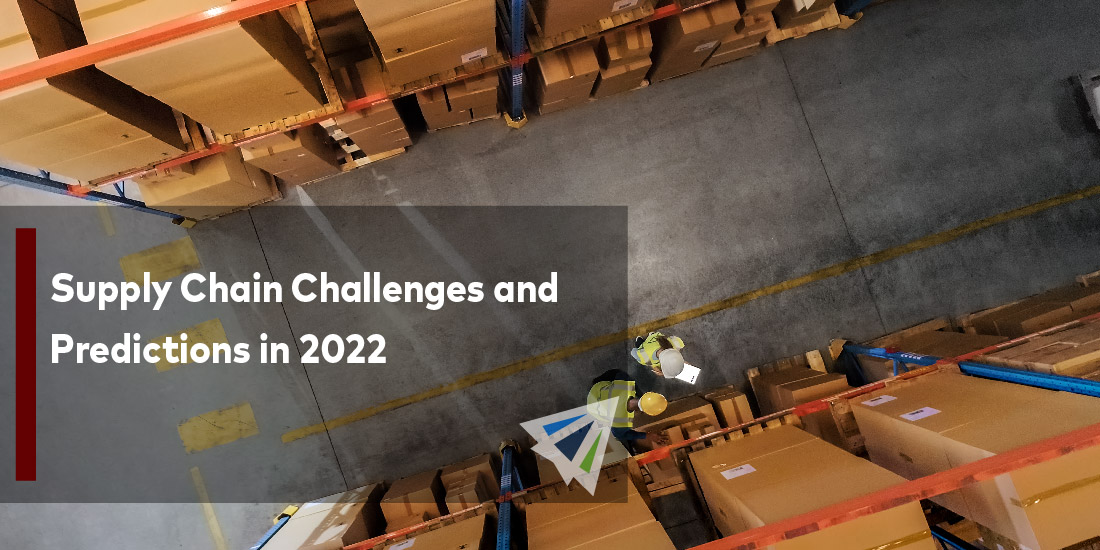Supply Chain Challenges and Predictions in 2022
Even just a month into the new year, 2022 already holds a lot of uncertainties as it pertains to international shipping. The last two years have been packed full of surprises. Whether it’s freight rates, capacity, congestion, port ground grid locks, worker strikes, or production issues. In 2022, everyone has their eyes set on reducing some of the volatility around these variables while also improving their practices. But what exactly does the new year hold for shippers?
Predictions: 2022 Supply Chain Forecast
The pandemic had an unpredictable effect on consumer demand and availability of goods. COVID shut down production facilities, and significantly lowered overall demand for restaurant supplies. However, demand for grocery store items soared as consumers stayed home. Chinese based production facilities (where most demand/purchases were coming from) were put under intense pressure amidst lockdowns and virus outbreaks, resulting in reduced throughput followed by a post-lockdown surge in production that bogged down U.S. ports.
Overall, since we are, seemingly, on the tail end of a pandemic, conditions are expected to improve. Challenges will remain, but the industry is shifting towards supply chain improvements.
With the acknowledgement that there is always a degree of volatility in our supply chain, what are some general trends and behaviors we can expect to see in 2022?
Efficiency and Speed Matter More Than Ever
The pandemic created a survival of the fittest global environment – or perhaps more accurately, survival of the fastest.
Those who were fast to decisions, bookings, and shipments thrived while those who were slow to them were snuffed out. Late decision making and poor routing or shipping choices lead to massive cargo delays, fees, order issues, and other factors detrimental to U.S. importers.
The digitalization efforts in supply chain are attempting to provide end-to-end visibility from the supplier’s supplier to the customer’s customer. Companies are trying to build a system of transparency and visibility across the board for all involved parties. Essentially, a robust supply chain control tower. However, it’s an incredibly long and strenuous journey to do so. There are myriad challenges that businesses face as they attempt to bring data management into the picture across several, in some cases hundreds or thousands, of involved parties (suppliers, manufacturers, buyers, end consumers, etc.,).
It’s expected to take a long time before this type of seamless data sharing and information management provides a clear picture of cargo to all involved parties. However, the good news is that companies are working towards it vigorously, which will ultimately result in a more efficient supply chain for everyone.
Job Availability vs. Workforce Disparity
An incredibly high number of workers have been leaving their jobs voluntarily. The Bureau of Labor reports an estimated 4.5 million workers have voluntarily left, which is a fast increase from the 4.1 million it was at just in October.
The reason? Jobs are becoming significantly more demanding without an increase in pay. Warehouse and production workers have been working significantly harder as consumer demand and eCommerce activity has risen drastically. Work hours have also increased, while pay has failed to follow suit.
Truckers, who are paid relatively well, are also leaving due to the increased pressure and long-hours. Carriers with an estimated $30 million in annual revenue reported seeing a 90% turnover rate.
So, the issue is not job availability as plenty of jobs are available to be filled. But amidst the supply chain crises of the last two years, work conditions have continuously pushed workers to a breaking point.
Of course, this change in workforce gives an extra nudge for technology to take on a greater deal of work in the supply chain. Predominantly on the production and transportation fronts, which leads to the last point.
AI and Self-Driving Trucks
We have heard about it for years in sci-fi stories and tech blog headlines, but the truth is, it’s already here. While it will certainly be a long time before self-driving trucks take over the entire trucking industry or AI replacing warehouse workers, we are moving in that direction—at a rapid speed.
There have been very few real-world applications of self-driving trucks thus far, but it’s expected the related technology will be applied in several ways in 2022. AI plays a huge role in the supply chain industry. It is a key component of Transportation Management Systems (TMS) and helps to improve carriers’ on-time service levels and increase visibility.
While a fleet of 100,000 automated trucks isn’t expected to hit the streets anytime soon, the self-learning AI technology that fuels this potential will be put into action. AI dash cams are going to be installed in many trucks, allowing it to read the surrounding environment and steer trucks clear of disaster. The data collected by these cameras and sensors can be used to improve trip safety and efficiency in the long run and is expected to have a significant impact on the industry at large.
Interested in learning more about the general trends and behaviors expected for our supply chain in 2022? Do not hesitate to contact one of our team members and we can evaluate how these industry developments affect your specific shipping situation.
